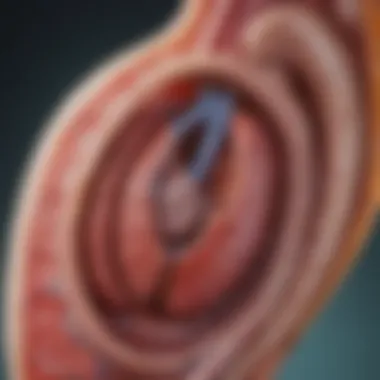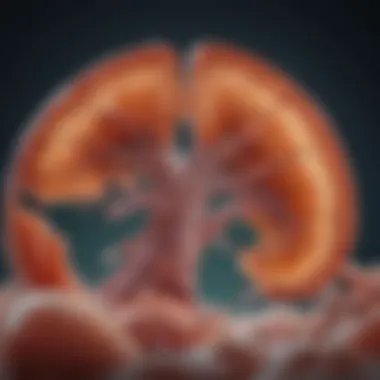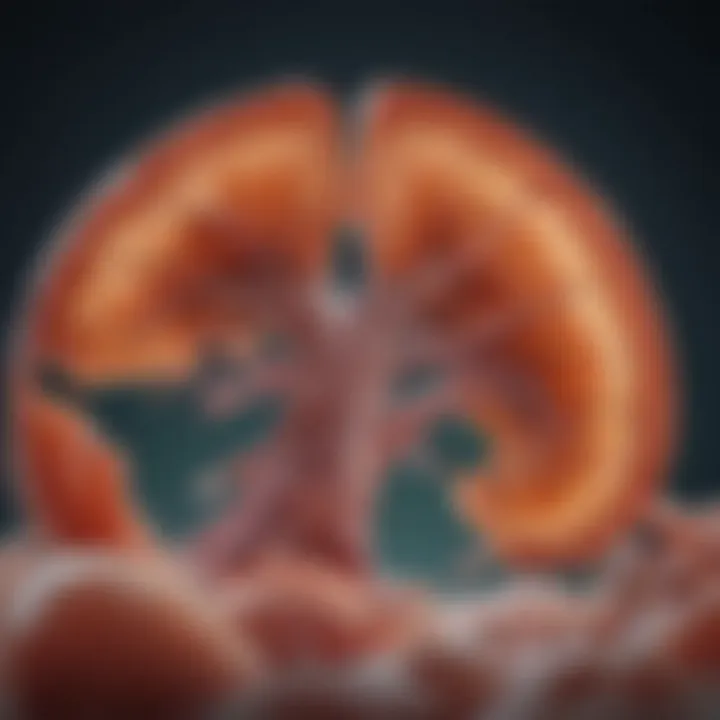Understanding Kidney Disease: Insights and Treatments


Intro
Kidney disease affects millions worldwide. Understanding its intricacies is essential for effective management and treatment. This section introduces the key concepts surrounding kidney health, outlining the critical aspects of pathophysiology and therapeutic options. By grasping the underlying mechanisms, readers can appreciate the significance of ongoing research and its implications for patient care.
The severity of kidney disease varies greatly. Some individuals may experience mild impairment, while others could face life-threatening conditions like end-stage renal failure. Early recognition of symptoms can improve outcomes and quality of life for patients. In the following sections, we will delve deeper into these critical topics, revealing not only the challenges but also the promising advancements in the field.
Research Overview
Methodological Approaches
Researchers employ a range of methodologies to study kidney disease. These include clinical trials, laboratory experiments, and epidemiological studies. Each approach has its unique advantages and challenges:
- Clinical Trials: These often involve patient populations and test new treatment strategies. Results inform practice and provide insights into effectiveness.
- Laboratory Studies: These yield fundamental knowledge about renal functions and disease processes at the cellular level. Techniques such as cell culture and animal models are common.
- Epidemiological Analysis: This method observes patterns and causes of disease in populations. It can highlight risk factors and guide public health initiatives.
Understanding these approaches is crucial for interpreting research findings related to kidney health.
Significance and Implications
The implications of kidney disease research are far-reaching. As the population ages and lifestyle-related conditions rise, kidney health is becoming increasingly important. Research findings influence clinical guidelines and treatment algorithms.
Ongoing studies aim to redefine how kidney disorders are diagnosed and treated. Precision medicine is emerging as a promising area. This approach tailors treatment based on genetic, environmental, and lifestyle factors. Through such advancements, patients may receive more effective therapies.
"The evolution of nephrology is driven by both basic science and the clinical needs of our patients. Understanding these elements is vital for improving outcomes."
Current Trends in Science
Innovative Techniques and Tools
Recent technological innovations offer new avenues for understanding and treating kidney disease. For instance:
- Biomarker Discovery: New biomarkers help determine disease progression and response to treatments. This can improve early detection and personalized management strategies.
- Imaging Techniques: Advanced imaging modalities such as MRI and ultrasound provide deeper insights into kidney structure and function.
- Artificial Intelligence: AI is transforming analysis in nephrology by helping to predict outcomes and personalize treatment plans.
These trends signal enhancements in the diagnostic and therapeutic landscape of kidney disorders.
Interdisciplinary Connections
The study of kidney disease is inherently interdisciplinary. Collaborations among nephrologists, researchers, and data scientists are critical. These partnerships foster innovation and lead to comprehensive care strategies.
Moreover, understanding the relationship between kidney health and other systems, such as cardiovascular health, enriches our collective knowledge. This integrative approach is essential for addressing the comorbidities associated with kidney diseases.
Foreword to Kidney Disease
Kidney disease stands as a major global health concern, affecting millions around the world. Understanding this topic is vital because it encompasses more than just the physical health implications; it connects to broad social, economic, and personal issues that arise from living with or treating kidney disorders.
The kidneys perform essential functions in maintaining bodily homeostasis. They regulate electrolyte balance, control blood pressure, and participate in metabolic waste excretion. A failure in kidney function can lead to severe health complications, making it imperative for individuals, healthcare professionals, and policymakers alike to be well informed about the nuances of this condition.
The spectrum of kidney disease includes various pathophysiological processes that lead to conditions like chronic kidney disease (CKD), acute kidney injury (AKI), and genetic disorders such as polycystic kidney disease. Each type comes with its own risk factors, symptoms, and management strategies.
Importance of Understanding Kidney Disease
- Public Awareness: Increased knowledge contributes to better public awareness, which, in turn, can lead to earlier detection and intervention.
- Clinical Insight: For healthcare professionals, grasping the complexities of kidney disease helps in devising effective treatment plans, which can ultimately improve patient outcomes.
- Research and Innovation: A comprehensive understanding paves the way for advancements in research, leading to innovative treatment options that may one day provide cures for these conditions.
"Addressing kidney disease is not merely a clinical obligation; it is a moral imperative that calls for a collective effort from all sectors of society."
The discussion around kidney disease clearly shapes individual experiences and healthcare practices. It is essential to foster an environment where knowledge is shared, enabling those affected to make informed health decisions. By delving into the various aspects of kidney disease, this article aims to provide a robust framework for understanding its implications and guiding effective management approaches.
Anatomy and Function of the Kidneys
The anatomy and function of the kidneys play a critical role in understanding kidney disease. These organs are vital not only for filtering blood but also for maintaining homeostasis in the body. An appreciation of their structure and operations provides essential insights that are useful for both clinical and educational purposes.
Structure of the Kidneys
The kidneys are two bean-shaped structures located on either side of the spine in the lower back region. Each kidney measures about 10 to 12 centimeters in length and is surrounded by a layer of fat that aids in protection and cushioning. The outer layer of the kidney is known as the renal cortex, while the inner layer—the renal medulla—contains structures called renal pyramids.
Within the kidneys are approximately one million nephrons each, the functional units that filter blood. Nephrons consist of the glomerulus, a network of tiny blood vessels, and the renal tubule, which processes the filtrate. The functional architecture of nephrons allows for efficient waste removal, electrolyte balance, and fluid regulation.
Overall, the organized structure of the kidneys enables them to perform complex filtering tasks necessary to maintain the body's overall chemistry.
Physiological Functions of the Kidneys
The kidneys have several essential physiological functions, which include:
- Filtration of Blood: The kidneys filter about 50 gallons of blood daily. They remove urea, creatinine, excess salts, and water, contributing to waste elimination.
- Regulation of Fluid Balance: By adjusting the volume of urine produced, the kidneys help maintain the body's fluid balance.
- Electrolyte Management: They control levels of key electrolytes, including sodium, potassium, and calcium, which are crucial for vital bodily functions.
- Acid-Base Homeostasis: The kidneys help regulate the body's pH level by excreting hydrogen ions and reabsorbing bicarbonate from urine.
- Hormonal Activity: The kidneys produce hormones such as erythropoietin, which stimulates red blood cell production, and renin, which plays a role in regulating blood pressure.
The complex functions that kidneys perform are essential to overall health. Any dysfunction in these processes can lead to significant clinical challenges, emphasizing the importance of understanding kidney anatomy and physiology in the context of kidney disease.


"The kidneys are not merely filters for the blood; they are finely tuned regulators of physiological balance."
Through this understanding, healthcare professionals can develop better strategies for preventing and managing kidney disease.
Etiology of Kidney Disease
The etiology of kidney disease is critical for understanding its onset and progression. Recognizing the underlying causes can guide effective interventions, enhance patient care, and inform preventative strategies. In this section, we will delve into the distinct factors that contribute to kidney disorders, including genetic predispositions, environmental influences, and the role of comorbid conditions. Each aspect sheds light on how they interlink with kidney health and disease, underlining the complexity of diagnosis and treatment.
Genetic Factors
Genetic factors play a pivotal role in kidney disease. Some individuals have inherited conditions that predispose them to renal issues, including Polycystic Kidney Disease and Alport Syndrome. These disorders manifest due to specific gene mutations affecting kidney structure and function. Understanding these genetic predispositions is essential for early diagnosis and intervention. For example, screening for genetic markers in families affected by inherited kidney diseases can facilitate timely management and patient education.
Moreover, genetic variation can affect the response to treatments. Personalized medicine is becoming increasingly relevant, allowing for tailored therapies based on genetic profiles. Researchers are exploring the potential of genetic testing as a predictive tool, which could transform the landscape of kidney disease management.
Environmental Influences
Environmental influences often interact with genetic factors, exacerbating the risk of kidney disease. High blood pressure and diabetes, both linked to lifestyle choices such as poor diet and inactivity, can lead to chronic kidney disease. Pollutants and toxins in the environment also play a role in renal health. Exposure to heavy metals, for instance, has been connected to kidney dysfunction.
Moreover, socioeconomic status significantly impacts life choices that affect kidney health. Limited access to healthcare and nutritious food can increase the incidence of conditions that compromise the kidneys. Thus, understanding environmental factors is essential in creating effective public health strategies aimed at reducing the incidence of kidney disease.
Comorbid Conditions
Comorbid conditions are frequently encountered by patients with kidney disease, and their management is critical. Conditions such as heart disease, diabetes, and hypertension are particularly common. The presence of these comorbidities complicates treatment options and often accelerates kidney decline.
Understanding the interactions between kidney disease and these comorbidities is essential for holistic patient care. For instance, managing blood pressure is not only important for cardiovascular health but also for preserving kidney function. Close monitoring and a coordinated approach involving various specialists can enhance outcomes for patients facing the dual challenges of kidney disease and other health issues.
"The interplay between genetic, environmental, and comorbid factors establishes the comprehensive framework for understanding kidney disease etiology."
Types of Kidney Disease
Understanding the types of kidney disease is crucial in recognizing the individual characteristics and management needs of patients. Each type presents unique challenges and requires tailored approaches for effective treatment. This section will delve into three prominent forms of kidney disease: Chronic Kidney Disease, Acute Kidney Injury, and Polycystic Kidney Disease. These forms reflect a spectrum of pathology and highlight the importance of early diagnosis and tailored interventions.
Chronic Kidney Disease
Chronic Kidney Disease (CKD) is a progressive condition characterized by a gradual loss of kidney function over time. Often, CKD goes unnoticed until it reaches advanced stages, emphasizing the need for vigilance in monitoring and early detection. The significance of CKD lies in its potential to lead to kidney failure, which necessitates dialysis or transplantation.
CKD can be classified into five stages based on the level of kidney function measured by the Glomerular Filtration Rate (GFR). Individuals may experience symptoms that include fatigue, swelling, and changes in urination patterns.
Management of CKD focuses on slowing the progression of the disease and includes:
- Lifestyle modifications: Diet and exercise play vital roles. Reducing salt intake can help manage blood pressure. A diet low in protein may reduce the kidney's workload.
- Medication management: Controlling blood pressure and managing diabetes are essential. Medications may include angiotensin-converting enzyme inhibitors and other antihypertensives.
Preventive strategies, such as regular screening for at-risk populations, can significantly impact outcomes.
Acute Kidney Injury
Acute Kidney Injury (AKI) represents a sudden decline in kidney function, which may occur over hours or days. This condition is often reversible if managed promptly. The importance of AKI lies in its association with increased morbidity and mortality, especially in hospitalized patients.
AKI can arise from various causes, categorized broadly into three groups:
- Pre-renal causes: These are due to inadequate blood flow to the kidneys, often resulting from dehydration or heart failure.
- Intrinsic renal causes: Damage occurs within the kidney tissue itself, commonly caused by toxins, infections, or prolonged ischemia.
- Post-renal causes: These are due to obstructions in the urinary tract, such as kidney stones or enlarged prostate.
Prompt identification of AKI symptoms, such as decreased urine output or sudden electrolyte imbalances, is essential. Treatment approaches vary, but interventions often focus on addressing the underlying cause and restoring kidney function.
Polycystic Kidney Disease
Polycystic Kidney Disease (PKD) is a genetic disorder characterized by the formation of numerous cysts in the kidneys, which can lead to enlarged kidneys and reduced kidney function. Recognizing the familial nature of PKD is crucial for genetic counseling and screening of at-risk individuals.
There are two types of PKD:
- Autosomal Dominant PKD: This type typically manifests in adulthood and leads to progressive kidney damage over time.
- Autosomal Recessive PKD: This is less common and often diagnosed in infancy or early childhood.
Patients with PKD may experience associated complications such as high blood pressure and urinary tract infections. Management of PKD focuses on controlling symptoms and monitoring kidney function through regular check-ups and imaging.
"Early diagnosis and management of any form of kidney disease is paramount to improving patient outcomes and quality of life."
Symptoms and Diagnosis
Symptoms and diagnosis are crucial in the context of kidney disease. Recognizing symptoms early can significantly influence outcomes. Since kidney disease can progress silently, often without noticeable signs, awareness of common symptoms is vital. Diagnosing the condition involves various laboratory tests and imaging techniques that provide essential insights into the kidneys’ functionality. This section aims to clarify these aspects, helping to form a comprehensive picture of kidney health.
Common Symptoms
Kidney disease manifestations vary widely, but some symptoms are more prevalent than others. Noticing these symptoms early can prompt individuals to seek medical attention. Common symptoms include:
- Fatigue: A pervasive sense of tiredness due to anemia, common in kidney impairment.
- Swelling: Fluid retention leads to swelling, especially in the legs, ankles, and around the eyes. This occurs due to the kidneys' inability to eliminate excess fluids.
- Changes in Urination: This can present as increased frequency, especially at night, or decreased output, indicating a potential dysfunction.
- Nausea and Vomiting: These symptoms may arise from a buildup of toxins in the body, suggesting the kidneys are not filtering effectively.
- Shortness of Breath: Can result from fluid accumulation in the lungs, a direct consequence of advanced kidney disease.
- High Blood Pressure: The kidneys help regulate blood pressure, so malfunction can lead to hypertension.
Awareness and recognition of these symptoms is essential for early interventions.


Laboratory Tests
Laboratory tests play a critical role in diagnosing kidney disease. Physicians typically recommend several specific tests to evaluate kidney function. These include:
- Serum Creatinine Test: Measures the level of creatinine in the blood, a waste product that kidneys usually filter out. Elevated levels can indicate impaired kidney function.
- Blood Urea Nitrogen (BUN): This test assesses the amount of nitrogen in the blood that comes from urea, another waste product. High levels can suggest kidney dysfunction.
- Urinalysis: A sample of urine is examined for abnormalities. This can reveal proteins, blood, or other irregularities that point to kidney issues.
- Glomerular Filtration Rate (GFR): A calculated value based on creatinine levels among other factors, GFR estimates how efficiently the kidneys are filtering blood.
These tests offer concrete data regarding kidney health and help guide treatment decisions.
Imaging Techniques
Imaging techniques are also significant in diagnosing kidney disease. They help visualize kidney structure and detect abnormalities. Commonly used imaging procedures include:
- Ultrasound: A non-invasive test that uses sound waves to create images of the kidneys. It can reveal size, shape, and any physical abnormalities, such as cysts or tumors.
- CT Scan: Provides detailed cross-sectional images of the kidneys, allowing for a comprehensive view of anatomy and any present masses or lesions.
- MRI: Though less common for routine kidney investigations, it offers detailed images without radiation exposure. Useful in cases needing further assessment.
- X-rays: These can be helpful for identifying kidney stones or other obstructions.
Utilizing these imaging techniques alongside laboratory tests provides a complete diagnostic framework, enabling tailored interventions and monitoring of kidney disease progression.
Understanding the symptoms and diagnosis of kidney disease is essential. This knowledge empowers individuals to take proactive steps in seeking treatment before complications arise.
Pathophysiology of Kidney Disease
The pathophysiology of kidney disease is a critical element of understanding both the progression and treatment of various renal disorders. It delves into the intricate mechanisms that lead to kidney damage, and how these mechanisms can influence overall health. Recognizing the pathophysiological processes aids in identifying therapeutic targets, developing new treatment strategies, and improving patient outcomes. This section emphasizes the significance of comprehending the underlying biological changes that occur in kidney disease.
Mechanisms of Damage
Kidney damage can result from diverse mechanisms, and understanding these can help clarify the complexities of kidney disease. Common mechanisms include ischemia, nephrotoxicity, and glomerular injury.
- Ischemia: Reduced blood flow to the kidneys can lead to injury, particularly in cases of acute kidney injury. This is often observed in conditions such as heart failure or significant blood loss.
- Nephrotoxicity: Certain medications and environmental toxins can directly damage the kidney cells. Drugs such as nonsteroidal anti-inflammatory drugs (NSAIDs) or certain antibiotics are notorious for their nephrotoxic effects.
- Glomerular Injury: Conditions like diabetes and hypertension can induce changes in the glomeruli, leading to proteinuria and progressive renal impairment.
Maintaining kidney function is vital not only for filtering blood but also for regulating electrolytes and blood pressure. Recognizing these mechanisms helps to tailor individualized treatment plans for patients.
"By understanding the exact mechanisms of kidney damage, healthcare providers can implement appropriate management strategies that may prevent or delay the progression of kidney disease."
Inflammatory Processes
Inflammation plays a vital role in the pathophysiology of kidney disease. Accumulation of inflammatory cells in the kidney can lead to further damage and scarring. The inflammatory response can be triggered by various factors, including infections, toxins, and autoimmune disorders.
- Cytokine Release: When kidney tissue is damaged, it releases cytokines that attract immune cells. This can result in a vicious cycle of tissue injury and inflammation.
- Fibrosis: Chronic inflammation often results in fibrosis, which is the thickening and scarring of connective tissue. This process impairs kidney function significantly over time.
- Immune Response: In some cases, autoimmune conditions can lead to unchecked inflammation, causing additional disruption to kidney architecture and function.
Understanding these inflammatory processes is essential for developing treatments that can mitigate inflammation. Anti-inflammatory medications may serve as adjunctive therapy in chronic kidney disease management.
Current Treatment Strategies
Understanding current treatment strategies for kidney disease is essential for effective disease management and improvement of patient outcomes. These strategies involve a multidimensional approach that incorporates lifestyle modifications, medication management, dialysis options, and kidney transplantation. Each element has its significance and considerations, whether for stabilizing chronic conditions or addressing acute issues.
Lifestyle Modifications
Lifestyle changes play a crucial role in managing kidney health. These modifications often focus on diet, exercise, and overall wellness. Reducing sodium intake helps lower blood pressure, which can be beneficial for people with kidney issues. A balanced diet rich in fruits, vegetables, and whole grains also supports kidney function. Regular exercise helps maintain a healthy weight, which is important since obesity can exacerbate kidney disease.
- Diet Management: Limiting protein, potassium, and phosphorus may be necessary depending on the severity of kidney disease. - Hydration: Staying properly hydrated is vital, but fluid intake may need to be restricted in advanced kidney disease. - Avoiding Alcohol and Tobacco: Abstaining from these substances can prevent further kidney damage and improve overall health.
"The benefits of lifestyle modifications extend beyond kidney health; they can enhance overall quality of life and emotional wellbeing."
Medication Management
Medications are often necessary for controlling the effects of kidney disease and preventing complications. Various classes of drugs may be employed based on individual needs:
- Antihypertensives: Control blood pressure, crucial in preventing further kidney damage. - Diuretics: Help to manage fluid retention; important for patients with congestive heart failure or high blood pressure. - Phosphate Binders: Assist in controlling phosphorus levels, which can build up in kidney disease. - Erythropoiesis-Stimulating Agents: Used to manage anemia associated with chronic kidney disease.
It is critical to tailor medication management to the patient’s specific condition and comorbidities. Regular monitoring and adjustments may improve effectiveness while minimizing adverse effects.
Dialysis: Types and Indications
Dialysis serves as an artificial replacement for lost kidney function when the kidneys can no longer maintain proper bodily homeostasis. There are two primary types of dialysis:
- Hemodialysis: Blood is circulated outside the body through a dialyzer, effectively removing waste products and excess fluid. Generally, this requires several sessions each week.
- Peritoneal Dialysis: This method uses the lining of the abdomen to filter blood, allowing for greater flexibility in lifestyle and schedule.
Indications for dialysis use include severe kidney failure where the kidneys can no longer function effectively, leading to a buildup of toxins in the body. Determining when to initiate dialysis is a nuanced process involving patient preferences, overall health, and the progression of kidney disease.
Kidney Transplantation
Kidney transplantation is often the most effective long-term solution for end-stage renal disease. This surgical procedure involves placing a healthy kidney from a living or deceased donor into a patient’s body. Successful transplantation can restore a better quality of life and reduce the necessity for dialysis.
- Eligibility: Not all patients are candidates for kidney transplant. Age, overall health, and specific kidney condition significantly influence eligibility. - Post-Transplant Care: Patients will require long-term immunosuppressant therapy to prevent organ rejection. Regular follow-ups are necessary to monitor kidney function and detect complications early.
Ultimately, kidney transplantation can provide a significant chance for a healthier life, but it comes with its own set of challenges and requires commitment to ongoing care.
Understanding current treatment strategies provides a foundation for both clinicians and patients in managing kidney disease effectively. Each aspect contributes to a comprehensive care plan tailored to individual needs and circumstances.


Innovative Therapies in Kidney Care
Innovative therapies in kidney care represent a significant advancement in the approach to managing kidney diseases. The field is evolving rapidly, reflecting the need for more effective treatments as traditional methods face limitations, particularly in chronic conditions. These approaches not only aim to improve the quality of life for patients but also focus on the underlying pathophysiology of the diseases, making them a crucial area of exploration in the kidney health continuum.
One major benefit of these therapies is their potential to restore kidney function or even regenerate damaged tissues. This represents a paradigm shift from merely managing symptoms to targeting and reversing the disease process, which could lead to improved long-term outcomes. However, it's essential to evaluate each innovative approach in the context of its efficacy, safety, and accessibility. Understanding these facets will help both healthcare practitioners and patients make informed decisions regarding treatment options.
"Innovative therapies have the potential to transform kidney care, moving beyond symptomatic relief to address the root causes of kidney disease."
Regenerative Medicine Approaches
Regenerative medicine encompasses various strategies aimed at repairing or replacing damaged renal tissues. One of the most promising areas is stem cell therapy, where stem cells are utilized to regenerate damaged nephrons—the functional units of kidneys. Experimental studies have shown that stem cells can differentiate into kidney cells, leading to significant improvements in renal function. Additionally, these therapies may reduce the reliance on dialysis or transplantation.
Another technique involves the use of bioengineering to create kidney-like structures. Researchers are working on developing organoids, miniaturized and simplified organs, that mimic kidney functions. This process includes not only stem cells but also biomaterials that support cell growth and organization. Importantly, regenerative approaches do not just treat symptoms—they aim to heal and restore the kidney’s innate abilities.
Gene Therapy Prospects
Gene therapy represents another cutting-edge method in kidney care. This therapy seeks to correct genetic defects at the cellular level. In the context of kidney disease, gene therapy might involve delivering functional copies of genes that are mutated or absent in patients. Such innovations are particularly promising for conditions that have a genetic basis, like Alport syndrome or certain forms of polycystic kidney disease.
Ongoing research is exploring viral vectors, which can transport therapeutic genes directly into kidney cells. This method has shown promising results in preclinical studies, signaling a potential breakthrough in treatment. Care must be taken, however, as the immune response to viral vectors could pose challenges in clinical applications.
In summary, innovative therapies, such as regenerative medicine and gene therapy, are paving new paths toward effective kidney care. They hold promise to significantly impact the treatment landscape, emphasizing the potential for healing rather than mere management of kidney disease.
Challenges in Kidney Disease Management
The management of kidney disease poses numerous challenges that can significantly affect patient outcomes. Understanding these issues is crucial for developing effective strategies in treatment and care. These challenges range from access to essential medical services to the complexities of ensuring patient compliance with treatment plans.
Addressing these elements is vital because they can hinder the effectiveness of treatments and increase the burden on both patients and healthcare providers. Acknowledging the barriers to care can lead to better resource allocation and tailored interventions, ultimately improving the quality of life for those affected by kidney disease.
Access to Care
Access to care refers to the availability and affordability of medical services for patients suffering from kidney disease. Various factors contribute to limited access, including healthcare inequality, geographical constraints, and economic barriers. In many regions, particularly rural areas, specialized kidney care may not be readily available, forcing patients to travel long distances to seek treatment.
Additionally, financial constraints can hinder individuals from pursuing necessary medical care. High costs associated with consultations, laboratory tests, and ongoing treatments such as dialysis are significant obstacles for many patients. The lack of insurance coverage or inadequate health plans exacerbates these challenges, especially for low-income populations.
It is essential to identify these gaps and work towards solutions that improve access to care. Some possible approaches include:
- Expanding telemedicine services to reach patients in remote areas.
- Developing community health programs that offer subsidized or free testing and treatment options.
- Advocating for policy changes that enhance insurance coverage for kidney disease management.
Patient Compliance Issues
Patient compliance is a critical component of successful kidney disease management. Non-adherence to treatment regimens can lead to significantly poorer health outcomes and increased complications. Issues affecting compliance can vary widely, ranging from a lack of understanding about the condition and its treatment to psychological barriers such as depression and anxiety.
The complexity of medication schedules often contributes to non-compliance. Patients may have difficulty managing multiple prescriptions or following dietary recommendations, which can lead to inconsistent treatment adherence. Furthermore, long-term treatment can create feelings of fatigue and frustration, lowering motivation to maintain compliance.
To combat these issues, healthcare professionals can implement several strategies to foster better patient adherence:
- Providing comprehensive education about kidney disease and its management.
- Simplifying medication regimens to make them more manageable for patients.
- Offering psychological support to help patients cope with the emotional burden of chronic illness.
- Utilizing follow-up calls and reminders to encourage regular check-ups and medication adherence.
Improving access to care and addressing compliance issues can significantly enhance the management of kidney disease, ultimately benefiting patients and healthcare systems alike.
In summary, recognizing and tackling the challenges in kidney disease management is vital for improving outcomes. By focusing on enhancing access to care and promoting patient compliance, healthcare providers can create a more effective and supportive environment for individuals living with kidney disease.
Future Directions in Kidney Disease Research
The field of kidney disease research is continuously evolving. As we gain better understanding of kidney dysfunction, new opportunities emerge to improve patient outcomes. Research currently focuses on innovative strategies to enhance diagnosis, treatment, and overall management of kidney disorders. The relevancy of these directions lies in their potential to alleviate the burden associated with chronic kidney disease and acute kidney injury.
Emerging Biomarkers
Emerging biomarkers present a promising frontier in the early detection and monitoring of kidney diseases. Traditional markers, such as serum creatinine, often fail to detect subtle kidney damage. Novel biomarkers, including urinary proteins and metabolites, allow for a more precise assessment of kidney function and injury.
These biomarkers not only help identify disease progression but also provide insight into underlying mechanisms of injury. For example, kidney injury molecule-1 (KIM-1) and neutrophil gelatinase-associated lipocalin (NGAL) serve as sensitive indicators of kidney damage. Implementing such biomarkers could enable earlier intervention and tailored therapeutic approaches for individual patients.
Advancements in Diagnostic Techniques
Advancements in diagnostic techniques have the potential to revolutionize the way kidney diseases are detected and classified. Imaging methods, including high-resolution ultrasound and magnetic resonance imaging (MRI), can visualize structural changes in the kidneys that traditional methods may miss. These techniques enhance our understanding of disease progression and may aid in selecting appropriate treatment modalities.
Moreover, integrating artificial intelligence (AI) into diagnostic processes can improve accuracy and efficiency. Machine learning algorithms have shown promise in analyzing complex datasets, allowing clinicians to make better-informed decisions regarding patient care. With ongoing research, these technologies are likely to become essential tools in kidney disease management.
Novel Drug Development
The landscape of drug development for kidney diseases is shifting towards more targeted therapies. Traditional medications often manage symptoms rather than address the root causes of disease. Novel compounds, including SGLT2 inhibitors like Empagliflozin and Dapagliflozin, have emerged as game-changers in the treatment of diabetic kidney disease, demonstrating effects that extend beyond glucose control.
Additionally, research into gene editing techniques, such as CRISPR, offers potential for addressing genetic forms of kidney disease. This approach could pave the way for personalized medicine, tailoring treatments based on genetic profiles. The dream of regenerative therapies that restore kidney function through biologics or stem cell modulation is no longer distant. These innovative paths necessitate rigorous clinical trials but hold the promise of transformative therapy.
"The future of kidney disease management hinges on our ability to innovate diagnostic and therapeutic strategies, ensuring better care for patients worldwide."
In summarizing the future directions in kidney disease research, one must note the immense potential that lies ahead. By focusing on emerging biomarkers, refining diagnostic techniques, and pursuing novel drug development, we can significantly enhance the landscape of kidney health. Delving into these aspects not only stems from a desire to advance science but also emphasizes the importance of patient-centered care in kidney disease management.
End
In an exploration of kidney disease, the conclusion serves as a pivotal summary that consolidates the various elements discussed throughout the article. It reflects the significance of understanding both the pathophysiology and treatment options available for kidney ailments. This understanding is crucial not only for healthcare professionals but also for patients and their families.
The landscape of kidney disease management is intricate, characterized by a range of conditions and treatment strategies. It is essential to recognize that early diagnosis and intervention significantly influence patient outcomes. By outlining the etiology, symptoms, and innovative treatment methods, the article emphasizes the need for a comprehensive approach to kidney health.
A well-informed discussion about kidney disease helps in the following ways:
- Promotes Awareness: Increased knowledge about kidney health leads to better prevention strategies and earlier detection of disease.
- Guides Research and Development: Understanding the underlying mechanisms of kidney disease promotes innovation in treatment and medication development.
- Fosters Patient Engagement: Empowering patients with knowledge encourages them to engage actively in their treatment plans, enhancing compliance.
"Understanding the complexities of kidney disease can ultimately lead to better outcomes, more personalized treatment options, and a higher quality of life for affected individuals."



